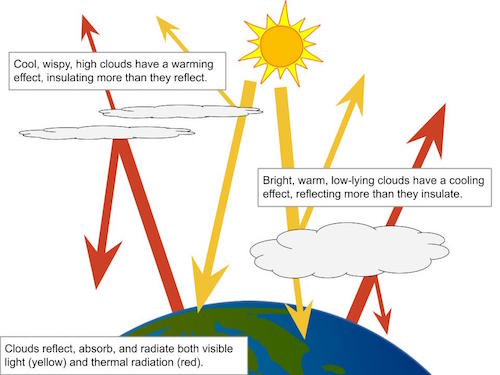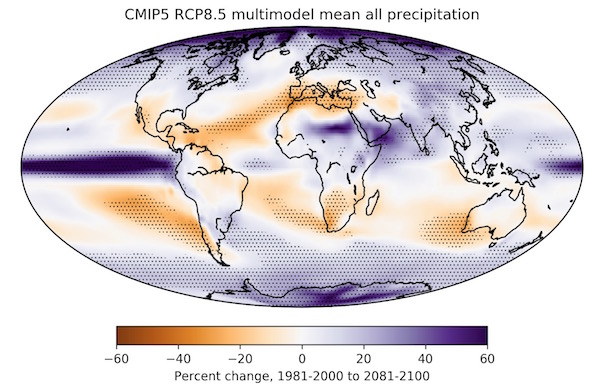
Clouds over the Americas. Source: NASA
Clouds Are Tricky
Clouds appear over about two-thirds of the Earth. They form when pockets of warm air rise into cooler air, where the water vapor condenses around particles like dust, sea salt, or sulfates into cloud droplets. (2) Other mechanisms, such as cooling at the tops of the clouds, help the clouds stay in place once formed.
Clouds have the potential to both cool and warm the Earth. They can cool the Earth because they reflect sunlight. They can warm the Earth because they trap the heat that’s radiating up.

In general, low-lying white cumulus clouds cool the Earth, while thin, high cirrus clouds warm the Earth. Blankets of low, highly reflective stratocumulus clouds critically cover about 20% of our tropical ocean area. According to one estimate, “the net effect of clouds on the climate today is to cool the surface by about 5°C (9°F).”

Stratocumulus clouds off of Baja. This type of cloud cools the Earth. Source: NASA
But there is a lot of uncertainty around clouds, and in particular how their impact will evolve as the climate warms. A change in cloud cover of just a few percent can have a big impact on temperature. Cloud location and quality also matter. We see that clouds are moving higher and polewards with warming temperatures, which will further warm the planet. But we also see them getting wetter, which has a cooling effect. The factors that affect cloud formation, such as atmospheric and oceanic currents, are themselves affected by climate change. A NASA writeup from about ten years ago emphasizes the predictive difficulty, noting that while our climate models at the time could predict temperatures and winds to within about 5% accuracy, the predictions for clouds and rainfall were only accurate to within about 25-35%. The picture below shows the rainfall predicted, on average, by the end of the century by a set of 38 climate models used in the recent IPCC-5 report. The dotted areas indicate where 90% of the models agree on the sign of the change. You can see there is significant disagreement among models. For large areas of the globe, including most of the United States, it’s not clear if there will be more or less total precipitation. (3)

Average percentage change in total precipitation between 1981-2000 and 2081-2100 for a high-warming scenario, averaged over 38 models. Dots indicate where 90% of those models agree on the sign of the change. Source: CarbonBrief
Understanding cloud behavior is clearly very complicated.
Clouds Are Important
It is also very important. As our climate quickly warms, we need to adapt to changes like flooding, drought, wildfire, sea-level rise, and more. These adaptations are very expensive, costing trillions of dollars in aggregate, and can take one or more decades to build. We want to start them early, but if we don’t know which impacts will occur where, and to what degree, we can waste huge amounts of money and effort. Tapio Schneider, an atmospheric scientist at CalTech, is passionate about this topic. In a recent panel at MIT, he asserted: “We need to know now, and very urgently, what happens in the next few decades”. (4)
Schneider is leading a new modeling effort that is bringing together atmospheric scientists, data processing experts, and machine learning leads to improve the accuracy of our models. As he explains, the behavior of clouds includes very small-scale processes (e.g., droplet formation) as well as much larger-scale interactions, which is too much to compute explicitly. The joint project between CalTech, MIT, the Naval Postgraduate School, and NASA’s Jet Propulsion Laboratory is building adaptive models that focus more on the small-scale processes, with constant improvement from masses of new data being collected by aircraft and satellites. (5) Schneider believes that his team will have much more accurate models in the next 5-10 years, not just “because we have to”, but because it is a “golden age” to make progress. Much more high-quality data is available, machine learning techniques have greatly improved, and processing power is high. Investments in this work can have a big impact because the stakes are so large. “The estimated economic value of reducing uncertainties in climate predictions by half is trillions of US dollars in societal benefit,” he claims.
Clouds Are Problematic
We have learned over the past few years that clouds are cooling the planet more than we previously thought. This is a “double whammy” of bad news, as Schneider puts it, because it means:
1. The climate is more sensitive to CO2 increase than we have been thinking. That is, the temperature increases faster as CO2 increases, but it’s been masked by the clouds.
2. As warming air disrupts the low cloud cover, there will be a positive feedback that warms the planet even faster.
On the latter point, a recent report from his team indicates that if the CO2 levels triple, cloud cover will essentially disappear. What would have been a 4°C increase in overall temperature, due to the increase in CO2, would instead be a 12°C increase in temperature. Scientists believe this may have happened about 56 million years ago, explaining crocodile bones that were found in the Arctic. That level of CO2 increase is somewhat unlikely, but what happens with clouds and precipitation at more realistic and near-term levels is of paramount interest. Evidence has been building over the past decade that the low (cooling) clouds will dissipate, leading to warmer temperatures, but the size of the effect is still an area of active research.
What About High Clouds?
High clouds (cirrus clouds) tend to warm the planet. They are not very reflective and so provide mostly insulating capability. The interesting thing in this regard is that we are increasing the number of these clouds through our use of aircraft. So-called “contrail cirrus clouds” that are generated behind planes at high altitudes contribute more to the planet’s temperature today than the CO2 emissions from aircraft. While this effect doesn’t last -- if the contrails disappeared, the temperature increase would disappear within days, unlike with CO2 -- the effect is large. Contrails have a particularly big warming effect at night, when there is no sunlight for them to reflect. In areas with many persistent contrails (in the US, that is primarily the midwest, southeast and northeast), nights are relatively warm. One study found contrails reduce the daily temperature range (night vs day) by about 3C. Another study found that, in the days after 9/11 when plane flights were halted, the daily temperature range went up by 1.8C in areas where contrails are most prevalent. (6)

Contrails over San Francisco. Source: NASA
And yet Americans are flying more than ever. A recent study found that the warming effect from aviation will be three times larger in 2050 than in 2006 if we do not make changes. Researchers think that one of the best ways to reduce contrails, short of flying less, is to reduce the soot being emitted from the engines. (Soot particles help the contrails form.) Another option is to adjust flight routes so there will be fewer contrails, or so they will have less effect. Flying in areas with warmer or drier air can weaken the contrails. Flying over darker areas, during the day when the contrails can reflect the sun, can also reduce their warming impact. Changing flight routes can increase cost and emissions, but at least some studies have shown that those impacts can be kept relatively small.
Summary
I ran across this topic by accident when I was trying to understand why estimates for aviation emissions differ so much from one another. My reading made me realize that I have been taking clouds for granted, but we cannot do that as we continue to warm the planet. Clouds provide all-important cooling and precipitation that support a diversity of habitats on Earth. Scientists are working to understand how our cloud coverage will be affected by global warming, and what that means for regional climates around the globe. In the meantime, we can all do our part to reduce our own emissions and to encourage aggressive policies that will help protect our clouds and our ecosystems.
Notes and References
1. If you are interested in learning more about clouds and some of the current work on them, Quanta Magazine has a nice overview that includes a paleo perspective. I also like this writeup from NASA. Though not as recent, it has lots of good background and is easy to read while still being thorough. CarbonBrief has a shorter writeup about some of the modeling challenges, Cosmos Magazine reviews some research from Down Under, and this NASA writeup explains how cloud predictions affect models' overall estimate of climate sensitivity.
2. There is a short video here demonstrating that particles are needed to build a cloud.
3. There is more information about rainfall projections here, part of a series by CarbonBrief on climate models.
4. MIT has been hosting a series of climate symposia, and I found this panel on “Frontiers in Climate Science” to be particularly good, though I wish it had been longer.
5. You can read more about the Climate Modeling Alliance here.
6. This summary about the effect of contrails on climate is based on a nice writeup from Yale, as well as a shorter one from Inside Climate News.
Current Climate Data (December 2019 / January 2020)
Global impacts, US impacts, CO2 metric, Climate dashboard (updated annually)
Comment Guidelines
I hope that your contributions will be an important part of this blog. To keep the discussion productive, please adhere to these guidelines, or your comment may be moderated:
- Avoid disrespectful, disparaging, snide, angry, or ad hominem comments.
- Stay fact-based and refer to reputable sources.
- Stay on topic.
- In general, maintain this as a welcoming space for all readers.



